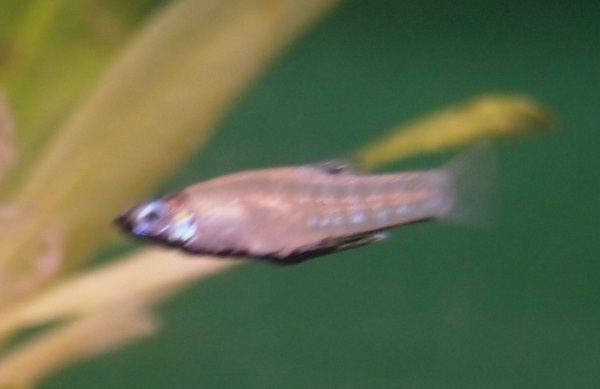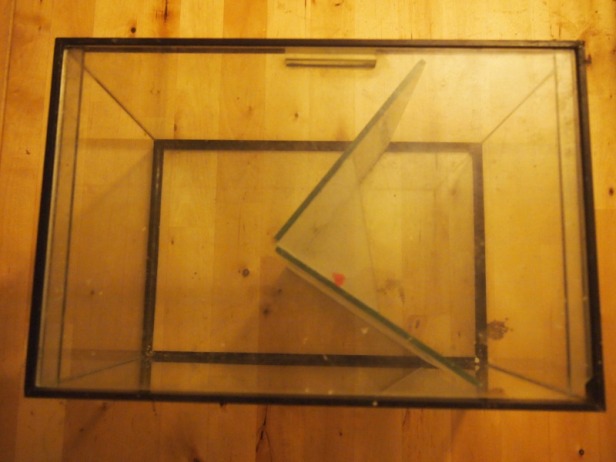Originally Published in 2012 in Issue 36 of the Livebearer News (Magazine of the British Livebearer Association)
Scientific Name: Giradinus metallicus
Habitat: This species is endemic to Cuba,
Common Names: Black Chin Livebearer, Metallic Topminnow
Size: Females to 70mm, Males to 35mm
Colouration: Males have black markings on the chest and gono-podium, this can be variable, sometimes the entire head may be black, sometimes fairly faint. Females are silvery shiny fish.

Introduction:
Giradinus metallicus was described in 1854 by Filipe Poey when he was 55. Poey was the first Professor of zoology at the University of Havana and also the founder of the Natural History Museum in Havana. The museum is still open to the public and still holds preserved specimens of fish that he collected.
Maintenance: This species does not require a large tank, I often use 18”x10”x10” tanks to keep a small colony – I tend to start with 2 or three pairs in a tank this size. However in a tank this small often fry will be eaten. A lar-ger tank of 24” would be fine for a larger colony and should reduce pre-dation on fry if you wish to flock breed.
Male Giradinus will chase females a bit, but do not seem to bother them overly much as the females are much larger, providing some cover in the form of plants will reduce the risk of stress from this quarter, but in reality it is not usually a problem. I tend to use Java Moss and Water lettuce for cover and this is perfect for the job.
This species spend most of its time in the upper third of the aquarium, this reflect its behaviour in its natural habitat, where it will eat insects from the water surface, very occasionally Giradinus sp. Are referred to as Top Minnows because of this. Because of this behaviour it is useful to have some sort of clean up crew in the tank, in order to eat food that otherwise would sit on the bot-tom, I have used Snails of various species for this as well as shrimps and Corydoras sp.
A weekly or fortnightly water change is plenty to keep them in tip top condition, they are certainly not particularly demanding of water quality. For filtration, an air powered sponge filter is perfect and will not suck up any fry, however a small internal power filter is ok and the fish will cope with the flow easily.
Breeding: They can be kept and bred in a wide range of conditions, pH can be either acidic or alkaline somewhere in the range of 6.5 – 7.5 would be suitable. Temperature should be 72-78of (22-26o.C), although temperatures outside this range would be tolerated for a while.
Gestation period is about 28 days, the female will produce between 10-30 fry, although more than 60 have been reported. The fry are pretty tough and easy to raise on suitable live food or dried food, I use frozen cyclops, dried plankton and finely powdered flake food with good results.
There are several methods that can be used to breed this species:
1-Flock Breeding AKA The Lazy method – just leave the parents in the tank to do what they normally do, if well fed and provided with top cover, you will get fry. Some may be eaten, but you should be able to keep a nice size colony this way. You can always remove any fry you see to raise separately for a few weeks until they are past the bite size stage.
2-Commercial fish breeding traps – Generally I do not recommend these as they are too small for many livebearers and tend to stress out females too much in my opinion. However I have used them with G.metallicus with no problems, except that the fry go to the top rather than the bottom so remember that you will have to provide some cover to stop the female snacking on them.
3 – Separate tank, or tank with vertical V trap – My favourite method as you will save most fry, this means you can place the female in the tank several days before dropping, reducing stress on her, and then you have a small tank to raise the fry in for a few weeks
 .
.
Raising the fry is straightforward and usually the fry can be place back with the adults with 2-3 weeks, or can be raised by them selves, the should sex out at about 8 week onwards.
In Conclusion:
Black chins are wonderful fish that are a delight to keep, especially if their tank gets a little bit of sunlight occasionally as they really shimmer, they seem to be getting a bit more popular in the last few years.
When researching this article I noticed that several sources list Costa Rica as a country it occurs in, this is most likely a mistaken id as the whole genus is endemic to Cuba.
Another common thing mentioned in some articles is the need to add salt to the water, I personally do not feel this is necessary at all, and have never found this to be needed.
There is a form available known as the yellow belly, with as the name suggests a yellow, rather than black belly, this form should be kept separate and not interbred with the black bellied form, it could end up being classed as a different species in the future.

Seven other species are in the genus Giradinus; creolus, cubensis, denticulatus, falcatus,microdactylus, reevsi, uninotatus. Occasionally some of these crop up from time to time, the most commonly available probably being falcatus followed by uninotatus.
This species is endemic to Cuba and has a wide distribution covering most of central cuba however when I visited the area in 2009 It was not easily found, in fact we only found 3 males despite looking in many places that should have held specimens, many of the areas we looked seemed to be suffering from the effects of pollution (drying up, smelly, high nitrates etc.) Although this species is established securely in the hobby, it may be in trouble in the wild.
